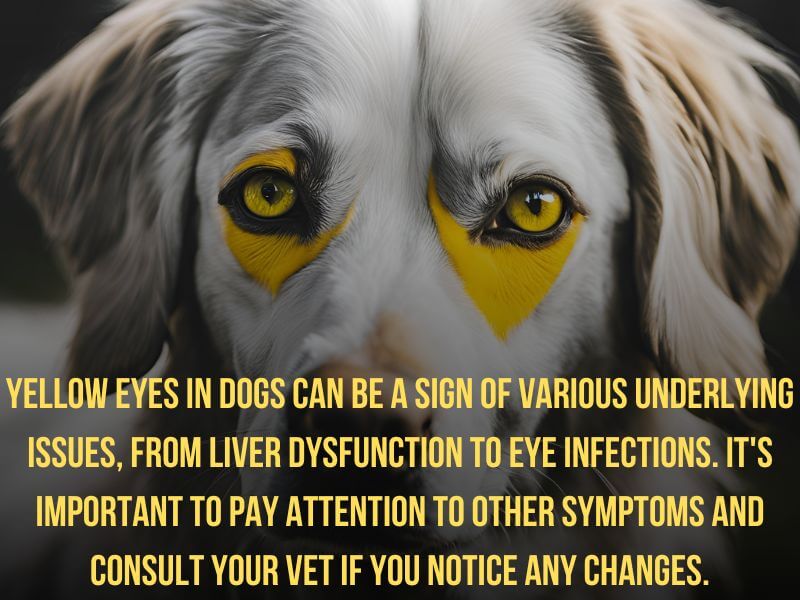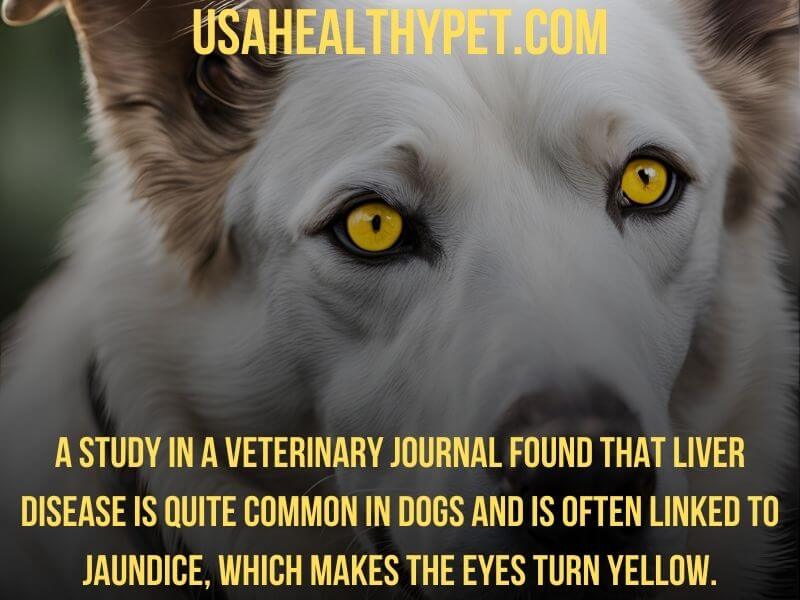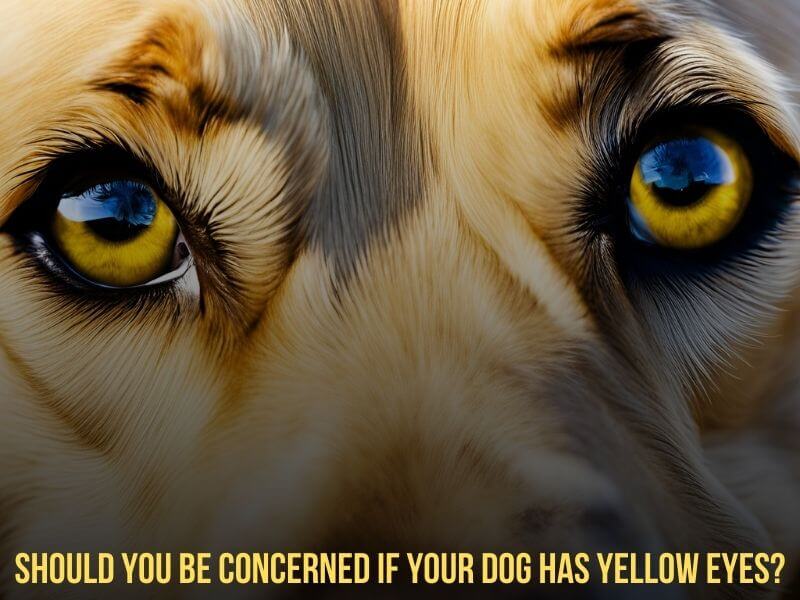Did you know that yellow eyes in dogs can indicate serious health issues? According to recent veterinary research, conditions like jaundice, liver dysfunction, and eye infections are common culprits.
So, should you be concerned if your dog’s eyes turn yellow? The answer is yes. This change often points to underlying problems that need immediate attention.
In this article, we’ll delve into the potential causes, key symptoms to watch for, and the steps you should take to ensure your dog’s well-being.
What Does It Mean When a Dog’s Eyes Turn Yellow?
When a dog’s eyes turn yellow, it usually means there’s something off with their health. This yellowing is often due to jaundice, a symptom rather than a disease.
The yellow color comes from a buildup of bilirubin, Bilirubin is a yellow pigment produced when red blood cells break down.
Possible Causes for Yellow Eyes in Dogs
Several health issues can cause a dog’s eyes to turn yellow. The most common include jaundice, eye infections, and leptospirosis. Let’s break down each of these conditions to understand them better.
Jaundice and Liver Dysfunction
One of the main reasons for yellow eyes in dogs is jaundice. This condition occurs when there’s too much bilirubin in the blood.
If your dog’s liver isn’t working properly, bilirubin can build up and cause the whites of their eyes (and sometimes their skin) to turn yellow.
A study in a veterinary journal found that liver disease is quite common in dogs and is often linked to jaundice, which makes the eyes turn yellow.
The research showed that many cases of jaundice in dogs are due to liver problems. This highlights how important it is to keep an eye on your dog’s liver health through regular check-ups.

Leptospirosis
Leptospirosis is a bacterial infection that can affect both humans and animals. It’s spread through the urine of infected animals and can cause severe liver and kidney damage, leading to jaundice.
Symptoms include fever, muscle pain, vomiting, diarrhea, and yellowing of the eyes. Early treatment with antibiotics is crucial to prevent severe complications.
Dr. John de Jong, who used to lead the American Veterinary Medical Association, says leptospirosis, a bacterial infection, can make dogs’ eyes turn yellow.
This happens because the infection can badly damage the liver and kidneys. He advises that vaccinating your dog and keeping them away from stagnant water where the bacteria live are good ways to prevent this illness.
Eye Infections and Inflammation
Sometimes, yellow eyes can indicate an eye infection or inflammation. This could be due to bacteria, viruses, or even trauma to the eye.
You might notice other symptoms like redness, swelling, or discharge in these cases.
Age-Related Changes
As our pups get older, their eyes can change too. While it’s not as common, some older dogs might develop a yellowish tint in their eyes due to age-related issues.
It’s always a good idea to keep an eye on any changes and consult your vet if you’re unsure.
Signs and Symptoms to Watch For
Yellow eyes are a pretty clear sign that something’s up, but there are other symptoms you should keep an eye on (pun intended!). Here are a few:
- Lethargy: Is your dog acting more tired than usual?
- Loss of Appetite: Are they not as excited about mealtime?
- Vomiting or Diarrhea: These could be signs of liver issues.
- Weight Loss: Unexpected weight loss is always a red flag.
- Behavioral Changes: Are they acting differently, like being more irritable or hiding?
If you notice any of these symptoms along with yellow eyes, it’s time to take action.

When to Consult a Veterinarian
So, when should you call your vet? The short answer is: sooner rather than later.
If your dog has yellow eyes, especially if accompanied by any of the symptoms we just talked about, it’s crucial to get them checked out.
Your vet can help determine the cause and the best course of action. Remember, it’s always better to be safe than sorry!
Diagnostic Tests
When you bring your dog to the vet with yellow eyes, they’ll likely perform a series of tests to get to the bottom of things. Here are some common ones:
- Blood Tests: To check liver function and bilirubin levels.
- Urinalysis: To see how the kidneys are working.
- Ultrasound or X-rays: To get a look at the liver and other organs.
- Eye Examination: To check for infections or inflammation directly in the eye.
These tests can help pinpoint the issue and guide your vet in creating an effective treatment plan.
Treatment Options for Yellow Dog Eyes
Once your vet figures out what’s causing your dog’s yellow eyes, they’ll recommend a treatment plan. Here’s a rundown of potential treatments:
Medications
If an infection is the culprit, your dog might need antibiotics or antiviral meds. For inflammation, anti-inflammatory drugs can help reduce swelling and pain.
Liver Support
If liver dysfunction is causing the yellow eyes, your vet might prescribe medications to support liver function.
This could include things like supplements, special diets, or medications to help with bile flow.
Surgery
In some cases, surgery might be necessary. This could be to remove a blockage or tumor that’s affecting the liver or bile ducts.
Symptomatic Relief
Treating symptoms like nausea, vomiting, or pain can help your dog feel more comfortable while the underlying issue is being addressed.
Prevention and Maintenance
While some causes of yellow eyes can’t be prevented, there are steps you can take to keep your dog’s eyes and overall health in tip-top shape:
- Regular Vet Check-ups: Routine exams can catch issues early.
- Balanced Diet: Feeding your dog a healthy diet supports overall well-being.
- Hydration: Make sure your dog always has access to fresh water.
- Eye Cleanliness: Keep your dog’s eyes clean and free from debris.
- Watch for Changes: Be observant of any changes in your dog’s behavior or appearance.
By staying proactive, you can help keep your furry friend happy and healthy.
Conclusion
Yellow eyes in dogs can be a sign of various underlying issues, from liver dysfunction to eye infections. It’s important to pay attention to other symptoms and consult your vet if you notice any changes.
With the right diagnosis and treatment, most dogs can recover and get back to their tail-wagging selves. Remember, your vet is your best resource for keeping your pup in great shape!
FAQs
1. Can yellow eyes in dogs be a sign of something serious?
Yes, yellow eyes can indicate serious conditions like liver dysfunction or eye infections. It’s important to consult your vet to determine the cause.
2. How can I prevent my dog’s eyes from turning yellow?
While not all causes can be prevented, regular vet check-ups, a balanced diet, and good hydration can help maintain your dog’s overall health.
3. Are certain breeds more prone to yellow eyes?
Some breeds may be more prone to liver issues, which can lead to yellow eyes. However, any dog can develop this symptom, so it’s important to stay vigilant.
4. What should I do if I notice my dog’s eyes turning yellow?
Contact your vet immediately. They can perform diagnostic tests to determine the cause and recommend the appropriate treatment.
5. Can yellow eyes in dogs be treated at home?
It’s crucial to consult a vet for proper diagnosis and treatment. Home remedies are not recommended for conditions that cause yellow eyes.

Pingback: Dog Airplane Ears: What Your Dog’s Ear Positions Mean
Pingback: Top Dog Breeds with Widow’s Peak: A Guide to Unique Looks